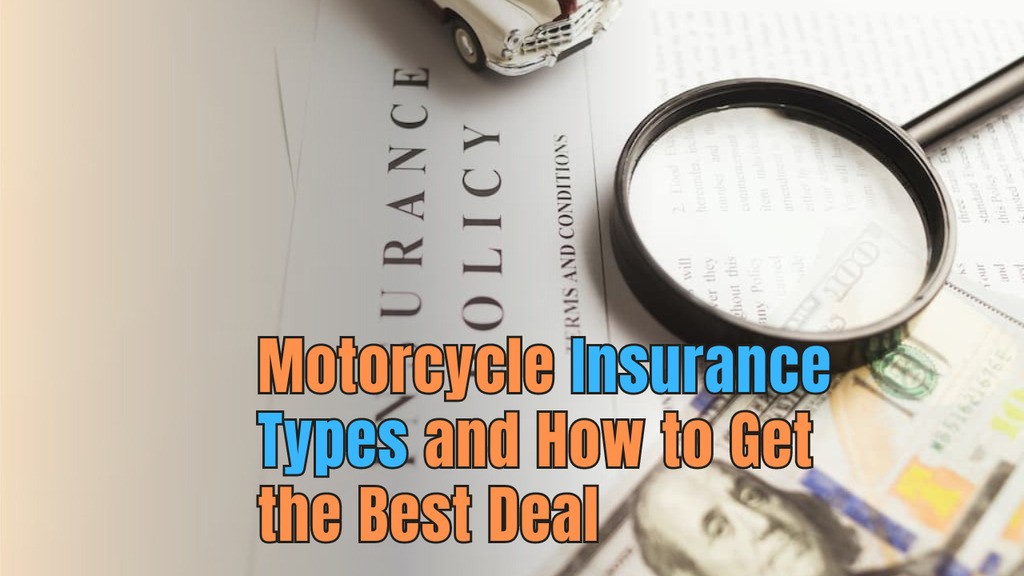Motorcycle insurance covers the damages to your motorcycle in the event of an accident. It also covers damage-related expenses, such as theft or vandalism, or if you damage someone else’s property with your bike.
Depending on your state, insuring your motorcycle might not be mandatory. But having coverage will give you the best financial protection if something awful happens.
The Different Types of Motorcycle Insurance
There are several insurance coverage policies. How can you select the right plan? It depends on various factors, including your state’s requirements, whether you plan to finance your bike, and how much coverage you want.
Here’s a quick overview of insurance coverage types for motorcycle:
Liability Insurance
Most states warrant this essential coverage. It covers injury and property damage that you cause to others. However, the plan does not protect you, your bike, or any damage you cause to yourself or your property. In some states, liability insurance is called “financial responsibility” insurance.
Liability coverage has two limits: a per-person limit and a per-accident limit. These limits are the maximum amount your policy will pay for bodily injury or property damage caused by you in an accident.
For example, you have a $100,000/$300,000 liability policy. So, the insurer will pay a maximum of $100,000 for one person’s injuries and $300,000 for everyone in an accident.
Collision and Comprehensive Insurance
Collision and comprehensive insurance are two essential plans.
Collision insurance covers damage to your motorcycle caused by a collision with another vehicle or object. Comprehensive insurance compensates for the damage caused by events that are not collisions, such as theft, fire, or vandalism.
Together, these two types of coverage can protect you from almost any physical damage that might befall your motorcycle.
SEE MORE: How to Avoid a Motorcycle Crash: 11 Tips to Follow
Uninsured/Underinsured Motorist Coverage
This type of motorcycle insurance covers you if you are hit by a driver who does not have insurance or who does not have enough insurance to cover the damages they have caused.
In some states, this coverage is required by law. Even if it is not needed, having this coverage is still a good idea to protect yourself in an accident.
Medical Payments Coverage
Medical payments coverage, sometimes called MedPay, is optional in most states. If you decide to purchase it, your provider will pay for the necessary medical expenses and, in some states, lost wages if you’re injured in a motorcycle accident, regardless of who is at fault.
Typically, MedPay will kick in after your health insurance coverage has paid its part. It can be used to cover deductibles and copayments that your health insurance doesn’t cover. Sometimes, it even covers funeral expenses.
Most MedPay policies have limits of $5,000, but you should ask the provider if you need higher limits.
Roadside Assistance Coverage
Roadside assistance coverage is an optional add-on product that can be tacked on to your motorcycle insurance policy for an additional premium.
What does roadside assistance cover for motorcycle riders?
The coverage can vary depending on your insurer. Still, it will generally cover the cost of towing your motorcycle to the nearest repair facility if it becomes disabled due to a mechanical breakdown. Some insurers will also cover the cost of labor at the repair facility up to a specific limit and the fee of other services like flat tire changes, jump starts, and lockout service.
Roadside assistance is not required by law, but it can be valuable coverage if your bike breaks down on the road. Having this coverage can be worth the extra premium.
SEE MORE: How Much Does Motorcycle Insurance Cost?
Factors Determining the Rates of Motorcycle Insurance
When shopping for motorcycle insurance, it’s essential to know what factors carriers will take into account to determine your rates.
Some of these determinants, like age and gender, are out of your control. But others, like your riding history and the type of bike you ride, are things you can change to get lower motorcycle insurance rates.
Some factors that affect motorcycle insurance rates:
Age: Riders under 25 tend to pay more for motorcycle insurance because they’re considered at higher risk.
Gender: Men typically pay more for motorcycle insurance than women because they’re more likely to take risks while riding.
Riding history: Riders with a clean driving record will usually pay less for premiums than those with accidents or traffic violations on their record.
Type of motorbike: Sportbikes and other high-performance motorcycles typically warrant a higher insurance cost than cruiser bikes or scooters.
Where you live: Motorcycle insurance rates can vary significantly depending on where you live. States, including Louisiana, Texas, and Michigan, have higher average rates. You will get lower rates in North Dakota, Iowa, and Oklahoma.
Learn more about the lowest and highest average motorcycle insurance rates here.
How to Get the Best Deal on Motorcycle Insurance
Before you start shopping for motorcycle insurance, you should know a few things. Since it can get expensive, you should shop around and compare rates before buying.
To get the best motorcycle insurance rate, do these things:
- Compare the rates from multiple insurers.
- Pay a higher deductible.
- Consider buying liability-only coverage if your bike is older or you have a good driving history.
- Pay your premiums in full to avoid interest charges.
- Ask for discounts.
Compare Quotes
The best way to find a cheap policy is to compare quotes from multiple insurers. To get an accurate comparison, provide each company with the same information, such as the make and model of your bike, your riding history, and the level of coverage you’re looking for.
You can also get a good sense of how much you’ll be paying by asking for quotes from companies that specialize in insuring motorcycles.
Choose a Higher Deductible
One easy way to lower your motorcycle insurance rates is to choose a policy with a higher deductible. It means you will be responsible for paying more out of pocket for the damages caused by the accident.
Many riders choose a low deductible, such as $250, to keep their out-of-pocket expenses down. However, this also means that their insurance rates will be higher. Paying a higher deductible can save a significant amount on your premium payments.
Make sure you can afford the higher deductible to repair or replace your motorcycle. Otherwise, you may find yourself in a financial bind.
Pay Your Premium in Full
One way to save on motorcycle insurance is to pay your entire premium upfront. Many companies offer a discount for this, typically around 10%. If you have a $1,000 annual premium, you’ll save $100 by paying all at once.
If you can’t afford to pay your premium in full, consider splitting it into two payments. Then, you’ll only have to pay the processing fee once. Check with your insurance company first to see if they charge a fee for this service.
Choose the Right Policy for Your Needs
To get the right motorcycle insurance coverage for your needs, you must first determine what those needs are. Are you looking for a policy covering you in an accident or theft? Or do you want coverage for both?
Once you know your needs, you can start shopping for the proper coverage. Many insurers offer different coverage options, so it’s necessary to compare several quotes before making a decision.
Be sure to read the policy carefully and understand what it covers and doesn’t cover. This way, you’ll know exactly what you’re getting and won’t be caught off-guard if something happens.
Take Advantage of Discounts
Most insurers offer various discounts that can save you money on your rates. To get the best deal, ask about all the discounts you may be eligible for, including those for:
Safety features: If your bike is equipped with certain safety features, such as anti-lock brakes or an airbag, you may be eligible for a discount.
Riding courses: Many insurers offer discounts to riders who have completed approved motorcycle riding courses.
Good drivers: If you have a clean driving record, you may be eligible for a discount.
Multi-policy: If you insure your motorcycle and another vehicle with the same insurer, you may qualify for a multi-policy discount.
Membership in specific organizations: You may be eligible for a discount if you are a member of an organization such as the AMA or AARP.
FAQs about Motorcycle Insurance Types and Best Deals
What are the different types of motorcycle insurance?
The main types are liability insurance, collision insurance, comprehensive insurance, medical payments coverage, and uninsured/underinsured motorist coverage.
Which type of coverage should I purchase?
At minimum, buy liability insurance to cover costs if you injure others or damage property. Collision and comprehensive coverage will reimburse you for damage to your motorcycle.
How can I save money on motorcycle insurance?
Purchase higher deductibles, take a motorcycle safety course, install anti-theft devices, store your bike in a garage, and bundle your motorcycle policy with other policies.
How often should I shop for lower insurance rates?
Shop for new rates at least once a year. Insurance companies frequently adjust their rates, so you may be able to find a better deal.
Will my age affect my insurance rate?
Yes, younger riders typically pay higher premiums due to greater risk of accidents and claims. Rates usually decrease as you get older and gain experience.
Will adding a second rider save me money?
Possibly, since insurers see two riders as lower risk. However, the second rider must also be an experienced rider with a good driving record.
Will changing bikes affect my insurance costs?
Insurance rates depend on many factors, including the bike make/model and safety features. Higher safety rated bikes generally cost less to insure.




